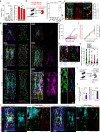Differential regulation of fetal bone marrow and liver hematopoiesis by yolk-sac-derived myeloid cells
- PMID: 40368906
- PMCID: PMC12078524
- DOI: 10.1038/s41467-025-59058-w
Differential regulation of fetal bone marrow and liver hematopoiesis by yolk-sac-derived myeloid cells
Abstract
Fetal hematopoiesis takes place in the liver before colonizing the bone marrow where it will persist for life. This colonization is thought to be mediated by specification of a microenvironment that selectively recruits hematopoietic cells to the nascent bone marrow. The identity and mechanisms regulating the specification of this colonization niche are unclear. Here we identify a VCAM1+ sinusoidal colonization niche in the diaphysis that regulates neutrophil and hematopoietic stem cell colonization of the bone marrow. Using confocal microscopy, we find that colonizing hematopoietic stem and progenitor cells (HSPC) and myeloid cells selectively localize to a subset of VCAM1+ sinusoids in the center of the diaphysis. Vcam1 deletion in endothelial cells impairs hematopoietic colonization while depletion of yolk-sac-derived osteoclasts disrupts VCAM1+ expression, and impairs neutrophil and HSPC colonization to the bone marrow. Depletion of yolk-sac-derived myeloid cells increases fetal liver hematopoietic stem cell numbers, function and erythropoiesis independent of osteoclast activity. Thus, the yolk sac produces myeloid cells that have opposite roles in fetal hematopoiesis: while yolk-sac derived myeloid cells in the bone marrow promote hematopoietic colonization by specifying a VCAM1+ colonization niche, a different subset of yolk-sac-derived myeloid cells inhibits HSC in the fetal liver.
© 2025. The Author(s).
Conflict of interest statement
Competing interests: The authors declare no competing interests.
Figures





References
-
- Maximow, A. Untersuchungen über Blut und Bindegewebe: I. Die frühesten Entwicklungsstadien der Blut- und Bindegewebszellen beim Säugetierembryo, bis zum Anfang der Blutbildung in der Leber. Arch. F.ür. Mikrosk. Anat.73, 444–561 (1908).
-
- Palis, J. & Yoder, M. C. Yolk-sac hematopoiesis. Exp. Hematol.29, 927–936 (2001). - PubMed
-
- Palis, J., Robertson, S., Kennedy, M., Wall, C. & Keller, G. Development of erythroid and myeloid progenitors in the yolk sac and embryo proper of the mouse. Development126, 5073–5084 (1999). - PubMed
MeSH terms
Substances
Grants and funding
- R01 HD094698/HD/NICHD NIH HHS/United States
- R35 GM119458/GM/NIGMS NIH HHS/United States
- PNC23-216751/American Association for the Study of Liver Diseases (AASLD)
- S10 OD023410/OD/NIH HHS/United States
- P30 DK078392/DK/NIDDK NIH HHS/United States
- NIH P30 DK078392/U.S. Department of Health & Human Services | NIH | National Institute of Diabetes and Digestive and Kidney Diseases (National Institute of Diabetes & Digestive & Kidney Diseases)
- R35 HL177125/HL/NHLBI NIH HHS/United States
- R01 DK141465/DK/NIDDK NIH HHS/United States
- R01 HL158616/HL/NHLBI NIH HHS/United States
- R01 HL153229/HL/NHLBI NIH HHS/United States
- 1R35HL177125/U.S. Department of Health & Human Services | NIH | National Heart, Lung, and Blood Institute (NHLBI)
- 1R01DK141465-01/U.S. Department of Health & Human Services | NIH | National Institute of Diabetes and Digestive and Kidney Diseases (National Institute of Diabetes & Digestive & Kidney Diseases)
- R01 HL136529/HL/NHLBI NIH HHS/United States
- U54 DK126108/DK/NIDDK NIH HHS/United States
LinkOut - more resources
Full Text Sources
Molecular Biology Databases
Miscellaneous

